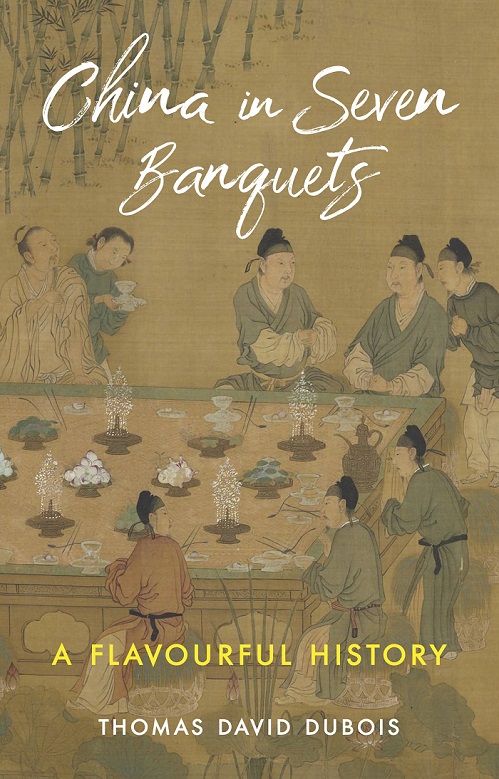Word Geostrategic Insights interview with Thomas David DuBois 杜博思 on the importance of culinary tradition in China’s history and heritage, the ongoing evolution in Chinese food culture, the priorities of food security, and whether Chinese cuisine can be a tool of China’s soft power in the world.

Thomas David DuBois is a historian of modern China and professor in the Beijing Normal University School of Chinese Language and Culture. His most recent book, China in Seven Banquets: A Flavourful History, was published in 2024 by Reaktion Books.
Q1 – You are a historian of modern China with a passion for cooking. In your recent book “China in Seven Banquets,” you trace 5,000 years of Chinese culinary history in seven iconic meals, from the ancient Eight Treasures Banquet to the Burnt Tail Banquet of the Tang Dynasty and the extravagant Han Manchu Complete Banquet of the Qing court. Your book includes numerous recipes, focusing on the evolution of culinary tastes, ingredients, techniques and practices from the Song Dynasty to the present day, recreating dozens of historical recipes in a modern kitchen. Max Miller, a New York Times bestseller known for his successful cooking programs, wrote, “Anyone who wants to understand Chinese food culture should read this book. …Much more than the history of food, this book is a history of China with a place at the table.” How important is culinary tradition in China’s history?
A1 – It’s no exaggeration to say that food is central to all aspects of Chinese culture. I’m not talking about excellent cuisine or cozy family meals, but rather the central role food has always played in China’s religion, philosophy, medicine and governance. The earliest political texts use the balance of flavors in a dish as a metaphor for the measured rule of a wise king. Diplomacy in ancient China was a function of correct protocol, which depended heavily on wine ceremonies and the meat that, like in ancient Greece, often came from temple sacrifices. That ancient tradition formed the foundation of China’s culinary culture. Even as culinary tradition evolved over the subsequent twenty-five centuries, picking up new tastes, techniques, and ingredients, that core remained intact, and evolved in step with other aspects of China’s culture. You can look at any Chinese state banquet or restaurant menu today and see the clear imprint of these fundamental ideas. Between then and now, the political and social centrality of food, including the specific dishes mentioned by Confucius or that appear in works of literature are overtly “traditional,” never waned, not once.
Culinary tradition today reveals itself in many ways. Culinary exhibitions and exchanges were one of the early diplomatic tools of the post-Mao era, and remain a key feature of state-to-state and people-to-people diplomacy, particularly among countries of the BRI. Cuisine is also a major tourist draw, both for the sort of foreign tourists that would take advantage of the new short-term visa free travel, and even more so among domestic tourists, who flock to places like Sichuan above all else to eat. This domestic market for local culinary specialties has gotten a huge boost from heritage programs, online shopping and web influencers that can bring instant (albeit fleeting) celebrity to an otherwise unremarkable place like the industrial city of Zibo.
Q2 – Nowadays, how are the emergence of large supermarket chains, online shopping and the proliferation of fast-food chains changing Chinese food culture?
A2 – By the time I first came to China in 1992, the era of ration coupons was over but shopping was still a fairly simple proposition. Fresh meat and vegetables came from one of a few street markets or impromptu street vendors, and staples like grain or cooking oil still came from state shops. Private shops only sold very basic items like bagged snacks or powdered orange drinks. Larger markets and foreign supermarkets made their way in over the next few years, but it was really only after China joined the WTO in 2001 that domestic cold chains caught up. After that, food became something you bought shrink wrapped in a store, and that distance between producer and consumer is one reason that people are uneasy about food quality and safety.
Restaurants followed a similar timeline. Over the past few decades, China transitioned from collective or canteen dining to home cooking and now to delivery—it’s a combination of habits and ease of use. When fast food like KFC first set up in 1988, the attraction was less the food than the convenience, cleanliness and brightly-lit dining area. But what fast food represented was the rise of pre-made food, which really took off in the 1990s with productive investment and especially after 2000 with branded franchising. If you look at the pressures on restaurants to decrease labor costs and kitchen area, you see why this new cooking model is impossible to resist. The same is true for delivery, even if the profit margins are razor thin.
Q3 – For millennia in China, food security has been inextricably linked to social stability. Even today, feeding China’s vast population is one of Beijing’s main concerns. What are China’s current food priorities and approach to food security?
A3 – The saying that “nine meals separate civilization from anarchy” rings very true in China, an traditionally agricultural country where even today most people live on farms. If you look at the very earliest books of Chinese political philosophy, one of the key concerns is how to keep the people fed. Emperors guaranteed the success of agriculture by conducting rituals at planting and harvest, and governments kept close watch on waterworks and grain prices, guaranteeing agrarian stability. Natural disasters that blighted agriculture, like drought or flood, were a sign of the displeasure of heaven, and every single case of popular unrest—including the ones that would ruin entire dynasties—was somehow started or accelerated by long or short-term hunger. Add to this the story of the Communist movement’s own rise, starting in the countryside and surrounding the cities, and you can understand the current government’s intense concern with food security.
For most of China’s history, food security meant having enough grain. Successive dynasties over hundreds of years maintained a system of emergency granaries that could distribute supplies anywhere in the country. Until relatively recently, each province was expected to be autonomous in grain production—a relic of the autarky policy inherited from its revolutionary Yan’an days.
More recently, China’s government has retooled its understanding of food security to account for global trade, as well as for threats that might come from the breakdown or malfeasance within its own production chains. The former was triggered primarily by the war in Ukraine, which provided an abject lesson about the politicization of food trade. What’s interesting is that the two main commodities, Ukrainian maize and American soybeans, are both used largely for animal feed, rather than direct human consumption. The latter was sparked by the constant drumroll of domestic production scandals, notably the Sanlu milk poisoning scandal of 2008. Both forms of food security have made their way deep into China’s ruling political consciousness.
Q4 – The Chinese take great pride in their food and culinary tradition. Is Chinese cuisine a remarkable cultural presence in the world, a globally recognized brand? Is it an important tool in China’s soft power strategy? Could China’s cultural and historical traditions be better shared with the world through the promotion of Chinese food?
A4 – I was recently asked to co-host an online series about the “Eastern Diet,” which was being proposed as China’s equivalent to the global success of the Mediterranean or Japanese diets. The problem was that I had just recovered from some serious health problems brought on in large part by the highly processed, extremely high fat and sodium content of food available in Beijing. It wasn’t always like this, certainly not before the hyper modernization of food chains over the past twenty years. That juxtaposition also got me thinking about what exactly is Chinese food? Usually when we see that kind of question, it is asking about authenticity, whether the cuisine of diasporic communities like American-Chinese or Indonesian-Chinese should properly count as Chinese food. But China’s food has been changing for centuries. It didn’t used to have chilis until recently, further back no onions, garlic or milled flour. Nobody would argue that spicy Sichuan food is inauthentic because it uses a foreign ingredient. So for me the “Eastern Diet” became a real question.
People have tried to export elements of Chinese cuisine, both products and brands. Individual dishes like Beijing roast duck didn’t appeal to a wider market, but the hotpot restaurant Haidilao has done well. But the most successful long-term Chinese food exports has also been the most diffuse: the small-scale family restaurant.
This shows why it is difficult to keep the message of cuisine “on brand,” in the same way as a more passive cultural experience like film. Events like cooking demonstrations or banquets turn the food itself into a kind of performance, placing the diner in a position to be impressed, like a museum exhibition that arrives course by course. But the appeal of food is more personal, and people prize experience that lets them explore and interact. Ultimately, the best way for China to increase the soft power of its cuisine is to encourage people-to-people interaction around the dinner table.
Thomas David DuBois – Historian of modern China and professor in the Beijing Normal University School of Chinese Language and Culture. Author of China in Seven Banquets: A Flavourful History.








